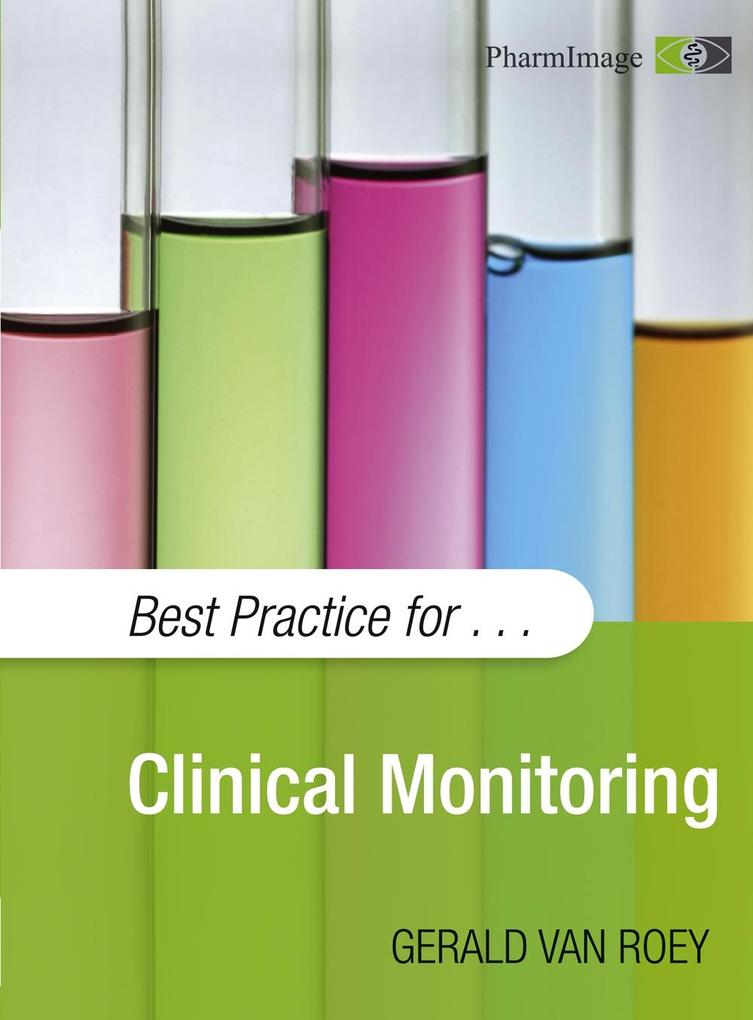
Sofort lieferbar (Download)
So you are interested in Clinical Research? Perhaps you are a curious person wanlng to know where medicalons come from and how they are tested; chances are higher that you have chosen to work in this area and are searching for background informalon. This book is developed for just that purpose: to help you understand how clinical research is performed, when, by whom, how and for what reason.
If you already have some experience in the field, you won t be dazzled by tons of new informa lon in this book, but youwill find some lps and tricks to help you perform your task in an even beier way. If you are new to the business, this book can guide you through your career and help you in understanding your tasks and responsibililes. This book is wriien with a focus on Clinical Research Associates, commonly called CRAs. These are the professionals who closely watch over the clinical research process. In this book they are called monitors to be in line with internalonal standards.
Either way, enjoy reading it and try to absorb as much knowledge as you can. You are invited to search through the chapter headings for specific topics or to simply read it from cover to cover for a complete understanding.
If you already have some experience in the field, you won t be dazzled by tons of new informa lon in this book, but youwill find some lps and tricks to help you perform your task in an even beier way. If you are new to the business, this book can guide you through your career and help you in understanding your tasks and responsibililes. This book is wriien with a focus on Clinical Research Associates, commonly called CRAs. These are the professionals who closely watch over the clinical research process. In this book they are called monitors to be in line with internalonal standards.
Either way, enjoy reading it and try to absorb as much knowledge as you can. You are invited to search through the chapter headings for specific topics or to simply read it from cover to cover for a complete understanding.
Inhaltsverzeichnis
1;1 An Introduction to Medicine andClinical Research;12 1.1;1.1 PRECLINICAL RESEARCH;14 1.2;1.2 CLINICAL RESEARCH;15 1.2.1;1.2.1 THE FUNDAMENTAL ELEMENTSOF A CLINICAL TRIAL;16 1.2.2;1.2.2 THE DIFFERENT PARTIES INVOLVED;19 1.2.3;1.2.3 PHASE I;21 1.2.4;1.2.4 PHASE II;22 1.2.5;1.2.5 PHASE III;23 1.2.6;1.2.6 PHASE IV;23 1.2.7;1.2.7 REGULATIONS GUIDING CLINICALRESEARCH;24 1.2.7.1;1.2.7.1 History;24 1.2.7.2;1.2.7.2 DeclaraQon of Helsinki;28 1.2.7.3;1.2.7.3 ICH-GCP;28 1.2.7.4;1.2.7.4 European legislaQon;30 1.2.7.5;1.2.7.5 Food & Drug AdministraQon;31 1.2.7.6;1.2.7.6 WHO;32 1.2.7.7;1.2.7.7 Other regulaQons;32 2;2 What Makes a GoodMonitor?;38 2.1;2.1 CHARACTERISTICS;38 2.2;2.2 RELATIONSHIP WITH THE INVESTIGATOR;39 2.3;2.3 TOOLS OF A MONITOR;40 3;3 Key Documents in ClinicalTrials / Documents to Know;46 3.1;3.1 PROTOCOL;46 3.2;3.2 INFORMED CONSENT FORM;48 3.3;3.3 CRF;50 3.4;3.4 INVESTIGATOR BROCHURE;52 3.5;3.5 SOURCE DOCUMENTS;53 4;4 Investigator Selection;56 4.1;4.1 SOURCES;57 4.2;4.2 COLD CALL;57 4.3;4.3 CONFIDENTIALITY;58 5;5 How to Prepare a Visit;62 6;6 Pre-Study Visit;66 6.1;6.1 WHAT TO CHECK;66 6.2;6.2 HOW TO CHECK;68 6.3;6.3 PROTOCOL READINESS;68 6.4;6.4 WHAT TO DO AFTER A VISIT;69 6.4.1;6.4.1 FOLLOW-UP LETTER;69 6.4.2;6.4.2 DOCUMENTATION;69 7;7 The Initiation Visit;76 7.1;7.1 TRAINING;76 7.2;7.2 HOW TO ...;77 7.3;7.3 WHAT TO DO AFTER AN INITIATION VISIT;78 7.3.1;7.3.1 FOLLOW-UP LETTER;78 7.3.2;7.3.2 DOCUMENTATION;79 8;8 Monitoring Visits;84 8.1;8.1 SOURCE DATA VERIFICATION;85 8.1.1;8.1.1 ELECTRONIC CRF;86 8.1.2;8.1.2 PAPER CRF;86 8.2;8.2 INVESTIGATIONAL MEDICINAL PRODUCT;87 8.2.1;8.2.1 DEFINITIONS;87 8.2.1.1;8.2.1.1 Inves7ga7onal medicinal product;87 8.2.1.2;8.2.1.2 Medical device;87 8.2.1.3;8.2.1.3 Accessory;88 8.2.1.4;8.2.1.4 AcYve implantable medical device;88 8.2.1.5;8.2.1.5 In vitro diagnosYc devices (IVD):;88 8.2.2;8.2.2 IMPORT AND EXPORT;88 8.2.3;8.2.3 IMP DISTRIBUTION;89 8.2.4;8.2.4 TRACKING OF IMP: SHIPMENTS;90 8.2.5;8.2.5 RETURN OF USED/UNUSED IMP;91 8.2.6;8
.2.6 TRANSFER;91 8.2.7;8.2.7 CERTIFICATE OF ANALYSIS;91 8.2.8;8.2.8 INVESTIGATIONAL PRODUCT;91 8.2.9;8.2.9 LABELING;92 8.2.10;8.2.10 SITE INVENTORY &PATIENT ACCOUNTABILITY FORM;92 8.2.11;8.2.11 STORAGE CONDITIONS;93 8.2.12;8.2.12 IMP DESTRUCTION;94 8.3;8.3 FILING;94 8.4;8.4 SITE MANAGEMENT;95 8.5;8.5 RECRUITMENT ISSUES;96 8.5.1;8.5.1 THE RIGHT PROTOCOL;96 8.5.2;8.5.2 SELECTION AND SUPPORT OF STUDY SITES;96 8.5.3;8.5.3 HOW TO HELP SITES?;99 8.5.4;8.5.4 KEEPING TRACK;100 8.6;8.6 SAFETY;102 8.6.1;8.6.1 ADVERSE EVENT (AE);102 8.6.2;8.6.2 ADVERSE DRUG REACTION (ADR);104 8.6.3;8.6.3 SERIOUS ADVERSE EVENT (SAE);105 8.6.4;8.6.4 SUSPECTED UNEXPECTED SERIOUSADVERSE REACTION (SUSAR);106 8.6.5;8.6.5 NOTIFICATION TO EC AND THEAUTHORITIES (EUROPEAN LEGISLATION);107 8.7;8.7 REPORTING BY THE MONITORS;108 8.8;8.8 WHAT TO DO AFTER A MONITORING VISIT;109 8.8.1;8.8.1 FOLLOW-UP LETTER;109 9;9 The Close-Out Visit;114 9.1;9.1 WHAT TO DO AFTER A CLOSE-OUT VISIT;115 9.1.1;9.1.1 FOLLOW-UP LETTER;115 9.1.2;9.1.2 DOCUMENTATION;117 10;10 Audits & Inspections;120 10.1;10.1 HOW TO PREPARE;121 10.2;10.2 DURING AN AUDIT OR INSPECTION;121 10.3;10.3 AFTER AN AUDIT;123 11;11 Reporting & Archiving;128 11.1;11.1 COMMUNICATION REPORTS;128 11.1.1;11.1.1 EXTERNAL;128 11.1.2;11.1.2 INTERNAL;129 11.2;11.2 SAFETY REPORTING;129 11.2.1;11.2.1 CIOMS REPORTS;129 11.2.2;11.2.2 LINE LISTINGS;129 11.2.3;11.2.3 ANNUAL SAFETY REPORT;130 11.2.4;11.2.4 CLINICAL STUDY REPORT;130 11.3;11.3 GOOD DOCUMENTATION;132 11.4;11.4 ARCHIVING;133 12;Appendix1 Answers to Self Study;136 13;Appendix2 List of Abbreviaions;140 14;Appendix3 Index;144
.2.6 TRANSFER;91 8.2.7;8.2.7 CERTIFICATE OF ANALYSIS;91 8.2.8;8.2.8 INVESTIGATIONAL PRODUCT;91 8.2.9;8.2.9 LABELING;92 8.2.10;8.2.10 SITE INVENTORY &PATIENT ACCOUNTABILITY FORM;92 8.2.11;8.2.11 STORAGE CONDITIONS;93 8.2.12;8.2.12 IMP DESTRUCTION;94 8.3;8.3 FILING;94 8.4;8.4 SITE MANAGEMENT;95 8.5;8.5 RECRUITMENT ISSUES;96 8.5.1;8.5.1 THE RIGHT PROTOCOL;96 8.5.2;8.5.2 SELECTION AND SUPPORT OF STUDY SITES;96 8.5.3;8.5.3 HOW TO HELP SITES?;99 8.5.4;8.5.4 KEEPING TRACK;100 8.6;8.6 SAFETY;102 8.6.1;8.6.1 ADVERSE EVENT (AE);102 8.6.2;8.6.2 ADVERSE DRUG REACTION (ADR);104 8.6.3;8.6.3 SERIOUS ADVERSE EVENT (SAE);105 8.6.4;8.6.4 SUSPECTED UNEXPECTED SERIOUSADVERSE REACTION (SUSAR);106 8.6.5;8.6.5 NOTIFICATION TO EC AND THEAUTHORITIES (EUROPEAN LEGISLATION);107 8.7;8.7 REPORTING BY THE MONITORS;108 8.8;8.8 WHAT TO DO AFTER A MONITORING VISIT;109 8.8.1;8.8.1 FOLLOW-UP LETTER;109 9;9 The Close-Out Visit;114 9.1;9.1 WHAT TO DO AFTER A CLOSE-OUT VISIT;115 9.1.1;9.1.1 FOLLOW-UP LETTER;115 9.1.2;9.1.2 DOCUMENTATION;117 10;10 Audits & Inspections;120 10.1;10.1 HOW TO PREPARE;121 10.2;10.2 DURING AN AUDIT OR INSPECTION;121 10.3;10.3 AFTER AN AUDIT;123 11;11 Reporting & Archiving;128 11.1;11.1 COMMUNICATION REPORTS;128 11.1.1;11.1.1 EXTERNAL;128 11.1.2;11.1.2 INTERNAL;129 11.2;11.2 SAFETY REPORTING;129 11.2.1;11.2.1 CIOMS REPORTS;129 11.2.2;11.2.2 LINE LISTINGS;129 11.2.3;11.2.3 ANNUAL SAFETY REPORT;130 11.2.4;11.2.4 CLINICAL STUDY REPORT;130 11.3;11.3 GOOD DOCUMENTATION;132 11.4;11.4 ARCHIVING;133 12;Appendix1 Answers to Self Study;136 13;Appendix2 List of Abbreviaions;140 14;Appendix3 Index;144
Produktdetails
Erscheinungsdatum
01. Januar 2011
Sprache
englisch
Seitenanzahl
145
Dateigröße
4,72 MB
Autor/Autorin
Gerald van Roey
Verlag/Hersteller
Kopierschutz
mit Adobe-DRM-Kopierschutz
Family Sharing
Ja
Produktart
EBOOK
Dateiformat
PDF
ISBN
9783862500024
Entdecken Sie mehr
Bewertungen
0 Bewertungen
Es wurden noch keine Bewertungen abgegeben. Schreiben Sie die erste Bewertung zu "Best Practice for ... Clinical Monitoring" und helfen Sie damit anderen bei der Kaufentscheidung.









